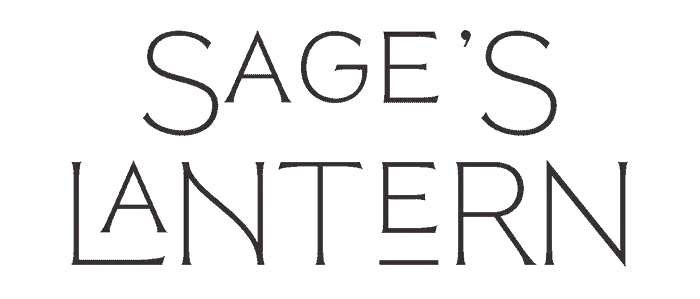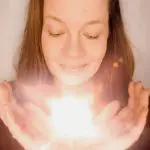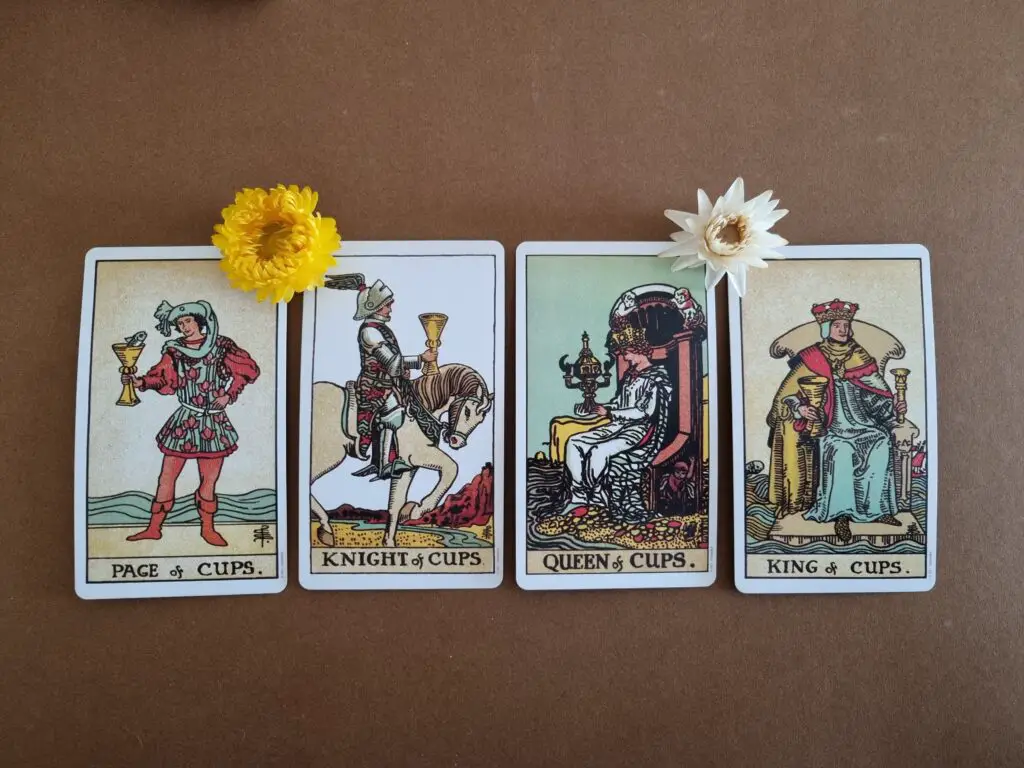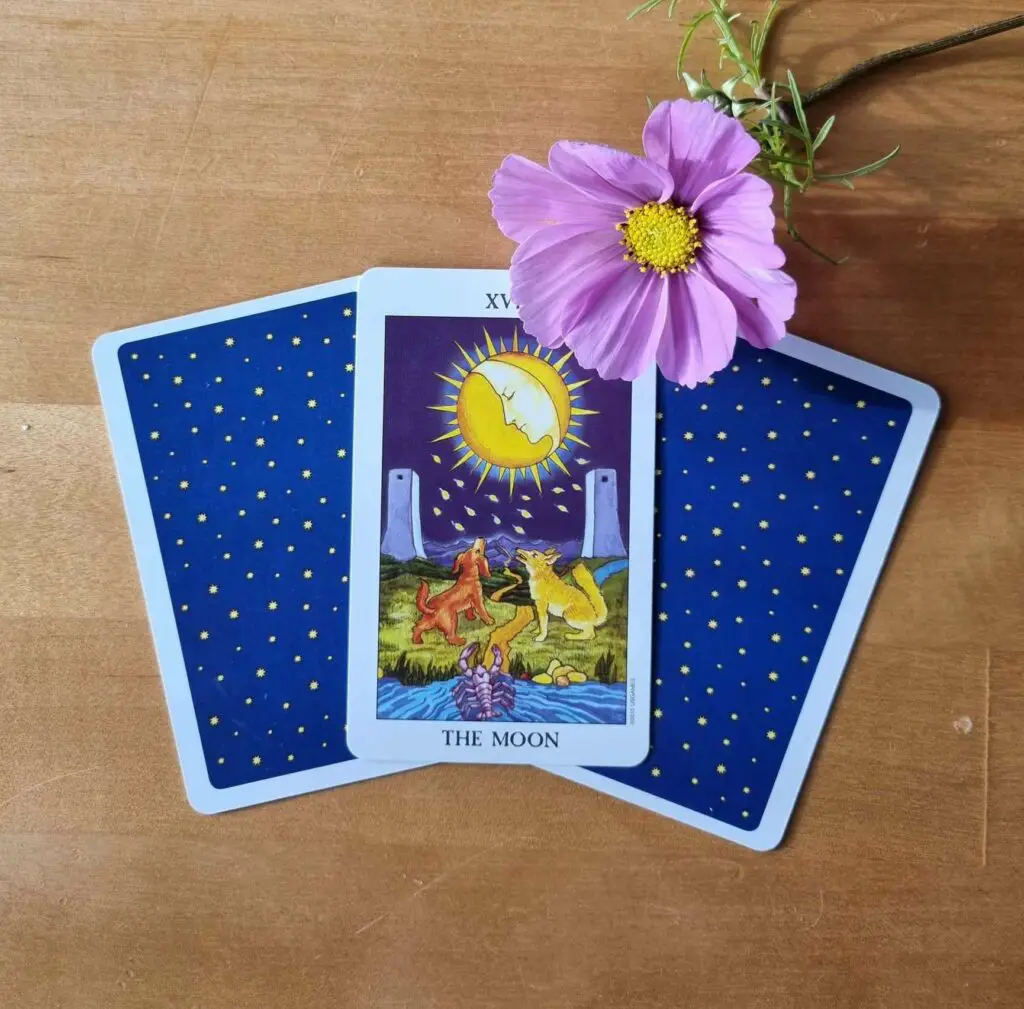When learning the Tarot, you are faced with many new technical terms that can be confusing at first. For example, what is a card spread? You hear the word everywhere; what are they talking about? Just stay put, and follow along. In this article, you will learn everything you need to know about Tarot card spreads.
A Tarot card spread refers to the layout in which you arrange the cards in a Tarot reading. The position of the cards within the spread mirrors different aspects of the question asked in the reading. With the help of the Tarot card spread, the Tarot reader is able to extract an in-depth answer.
The card spread refers to the layout of the cards. With the help of the layout, the Tarot reader can decode the answer from the reading. The card spread is thus, the heartbeat of the Tarot reading. By choosing a good spread, you will receive clear answers – every time.
WHAT IS A TAROT SPREAD?
A Tarot spread is a layout in which you arrange the cards. Depending on the question being asked, the spread might differ from reading to reading.
There are no rules that regulate how many cards to include or how a spread should look. There are very simple spreads with one to five cards, or complex ones with ten or more (for example the Celtic Cross).
The great thing is, though, there is always a spread that fits your style, experience, and need.
Tarot readers refer to books, websites, or guides for general reading spreads. For readings with a specific question, they often create a custom spread on the fly.
The cards within the layout have different meanings, and the reader decodes the answer by interpreting the meaning of the position and the card in conjunction.
Reading Tarot cards is a multilayered and multifaceted experience. The card spread is helpful as it breaks down the question into parts. This is very useful as it helps you get in-depth insights into the energies at play.
WANT TO LEARN MORE?
Learn everything you need to know about general Tarot readings.
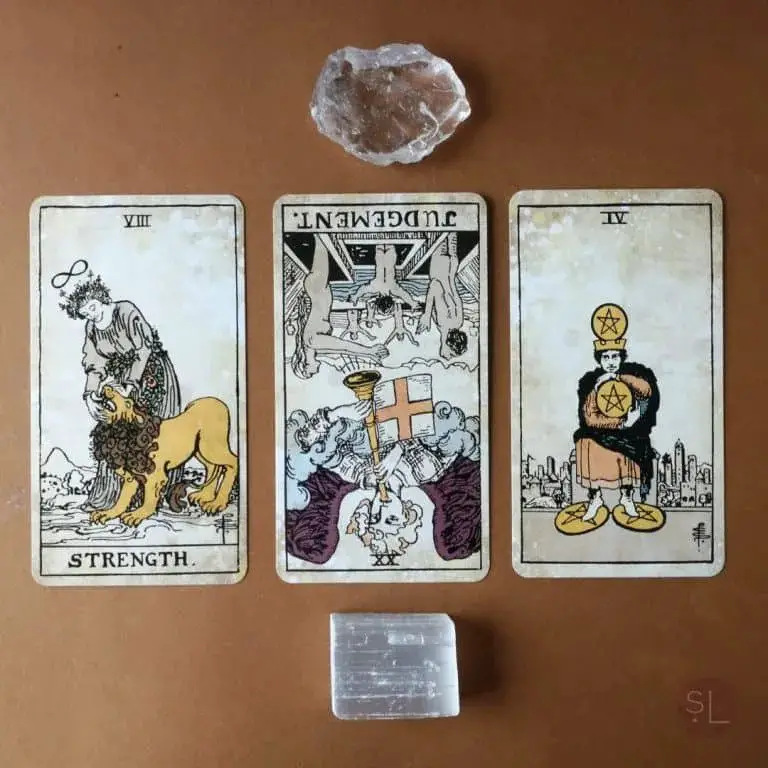
DIFFERENT TYPES OF TAROT SPREADS
There are two main types of Tarot spreads; custom and fixed Tarot spreads (often used for general readings). In the custom card spread, the Tarot reader gives the positions different meanings to answer a specific question.
A tarot spread can have positional values or no positional values. A Tarot reader might draw three cards to answer one question; this spread has no positional values.
The Tarot reader draws three cards with three specific positional meanings. The cards independently answer three aspects of the central question being asked.
In a general reading, there is no specific question asked. In this case, it is common to use a fixed Tarot spread, for example, the Celtic Cross or “Past, Present, Future.”
- Fixed Tarot spreads (general reading spreads)
- Custom Tarot spreads (answers a specific question)
- Positional values
- No positional value
Of course, as always, nothing is black and white when it comes to the Tarot. There might be exceptions where you might use a general reading spread for a specific reading and vice versa. Likewise, there might be indications where you can both positional values and cards without. Who said Tarot is easy, right?
There are no rules on how a Tarot spread layout should look. It can be horizontal, linear, or a combination of both. The design can also be geometrical shaped, like a star or pentagram, for example.
In the picture below is a horseshoe-shaped layout. This is a common layout. There are myriad variations of it.
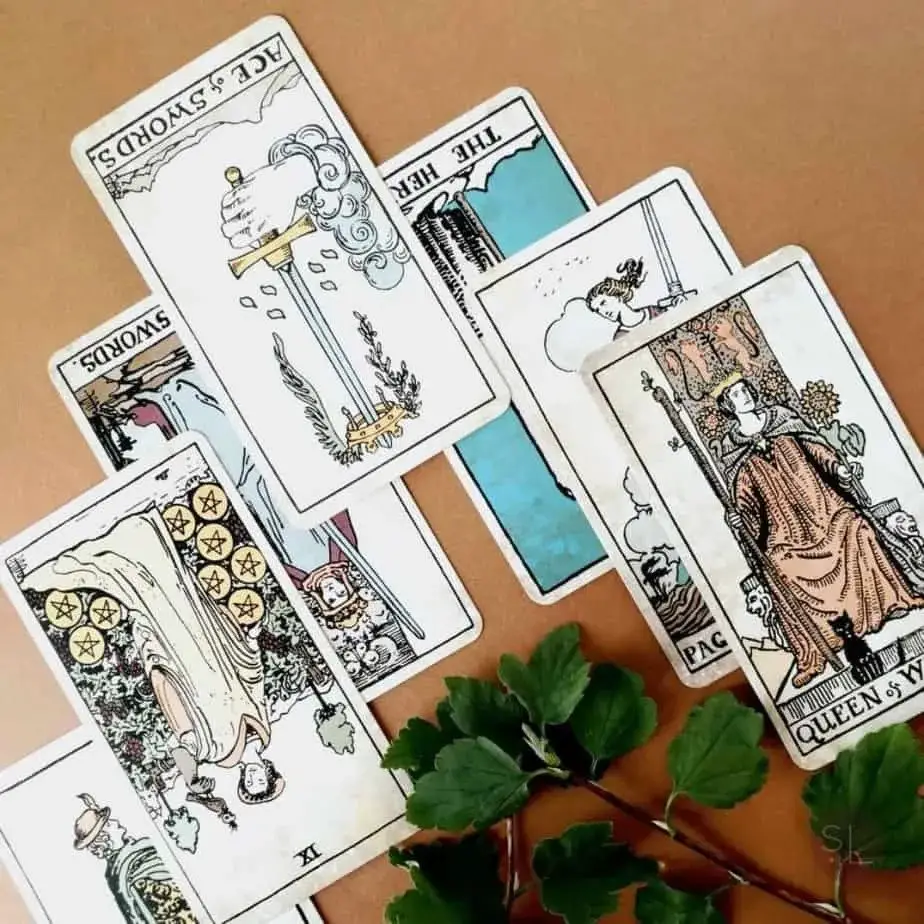
WHAT IS A TAROT CARD SPREAD FOR?
The card spread helps you interpret the card reading and is an essential part of the Tarot reading. Without the card spread, you are not able to extract the answer. In some way, the Tarot is the card spread in conjunction with intuition and knowledge of the card’s meanings.
A card spread helps you to look at the question from different viewpoints. It makes it possible for you to target the question and get the most valuable answers.
Choosing the proper spread for reading is something that comes with practice and experience. This can be as hard as learning the card meanings themselves, but I promise with time and experience, creating or choosing a spread will become second nature. Just hang in there!
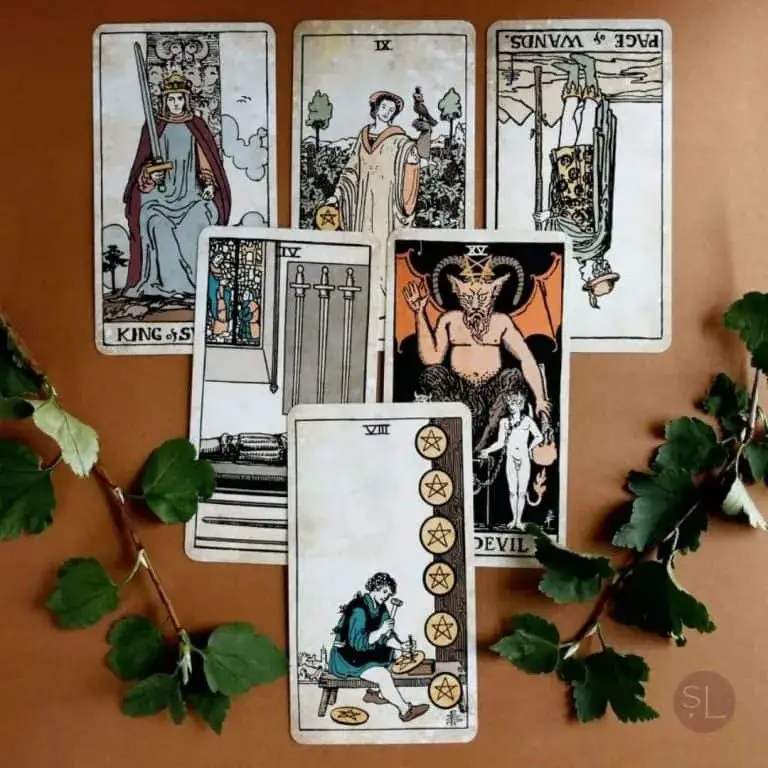
DIFFERENT KINDS OF TAROT CARD SPREADS
There are endless Tarot spreads available, from answering questions about love, grief, or career. There’s a Tarot card spread for all human experiences.
Below you find a massive list of themes for Tarot spreads. The list is a summary of what I found on Etsy, tarot reading services, Tarot spread books, and my personal notebooks.
Create a custom spread or find readymades on websites, books, or guides. I hope this list helps you open up your mind to what is possible to explore with the help of the Tarot. There’s a spread for every question imaginable.
Different themes or topics for spreads
- Love
- Career
- Spiritual
- Daily
- Yearly
- Success
- Twin-flame
- Abundance
- Friendship
- Outcome
- Forecast
- Motherhood
- Fatherhood
- Parenthood
- Relocation
- Crossroads
- Yes or No
- “A” or “B”
- Loss/Grief
- Education
- Divorce/Break-up
- Healing
WHAT TAROT SPREAD SHOULD I USE?
Depending on what type of question you want to answer, the Tarot spread differs.
If you are seeking general direction, a general Tarot spread is a way to go. If you need answers to a specific question, a custom spread is a solution.
Your level of experience and knowledge about the Tarot is also a factor when deciding what spread to use. If you are a beginner, a Celtic Cross might be too complicated. In that case, a one to three-card spread might be the best solution.
My recommendation is to choose a spread that you can handle and have joy reading. Don’t force yourself to read complicated spreads, just for the sake of it. Often less is more. You have less of a chance of diluting the answer if you have fewer cards.
But as always, you do you! All Tarot readers have their groove, vibe, and style.
WHAT TAROT SPREADS ARE BEST FOR BEGINNERS?
The best Tarot card spreads for beginners are one to three-card spreads. Start practicing general readings to get the hang of it.
When you get more experienced, try creating custom spreads targeting specific questions. My recommendation is to start with one or two cards and level up as you grow.
A spread should never confuse or frustrate you. As soon as this happens, you risk losing your vibe or connection with your intuition. If this happens, no worries though, try again with a more constrained spread.
Tarot should be fun and “effortless.” The best readings are those that flow naturally. If you need to think more about the spread than the message itself, it’s a good idea to step back and try a less complex spread.
Place your cards facing up or down – do what feels best for you. If you lay them facing down, turn one card at a time. This can be a great solution if you feel more confident when reading the cards “one by one” rather than in a context. As a beginner, it is easy to get overwhelmed by too many cards at once.
In the picture below, I turn one card at a time in a three-card spread.
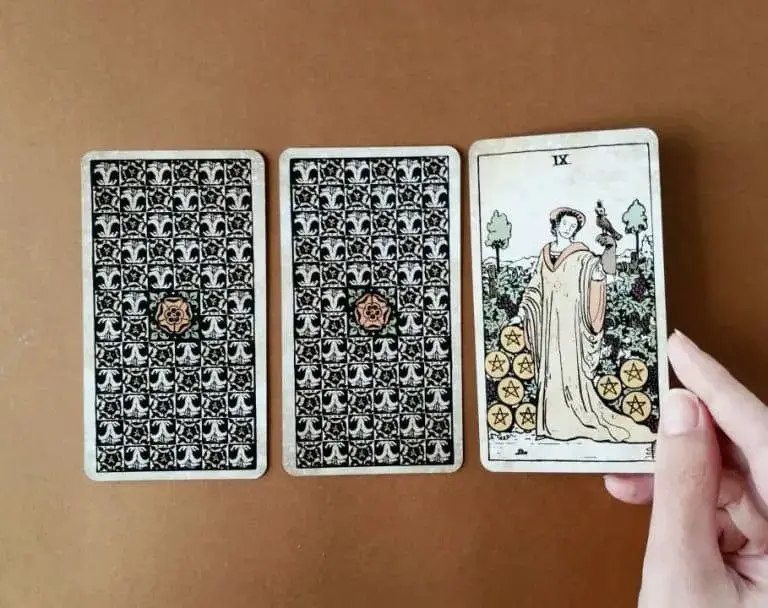
TAROT SPREAD EXAMPLES FOR BEGINNERS
There are endless opportunities when it comes to Tarot card layouts and spreads. These are my favorite one- to three-card arrangements that are suitable if you are a beginner.
Start with a one-card spread and add cards as you feel confident. Change the “X” to the question you need answering. Have fun and experiment with different styles of questions and topics. If you get stuck, check the list above for inspiration on topics.
ONE-CARD TAROT SPREAD EXAMPLES
These are the easiest to start with. Shuffle your Tarot deck and pull one card. Place it in front of you. You don’t need to read reversals (when the card is placed upside down) if you don’t want to. Pin it to your Pinterest for easy access.
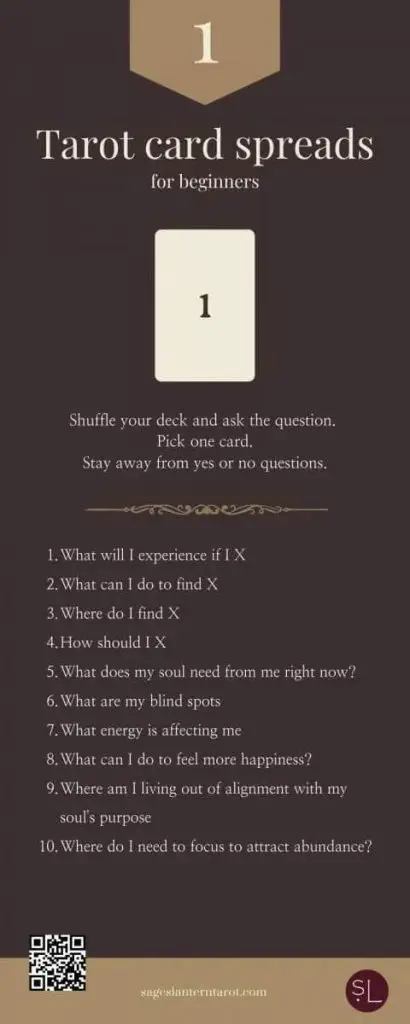
The ten most potent one-card Tarot spreads for beginners
- What will I experience if I X
- What can I do to find X
- Where do I find X
- How should I X
- What does my soul need from me right now?
- What are my blind spots
- What energy is affecting me
- What can I do to feel more happiness?
- Where am I living out of alignment with my soul’s purpose
- Where do I need to focus to attracting abundance?
TWO-CARD TAROT SPREAD EXAMPLES
A two-card Tarot spread gives you a little more depth to your reading. You don’t need to read reversals (when the card is placed upside down) if you don’t want to. Pin it to your Pinterest for easy access.
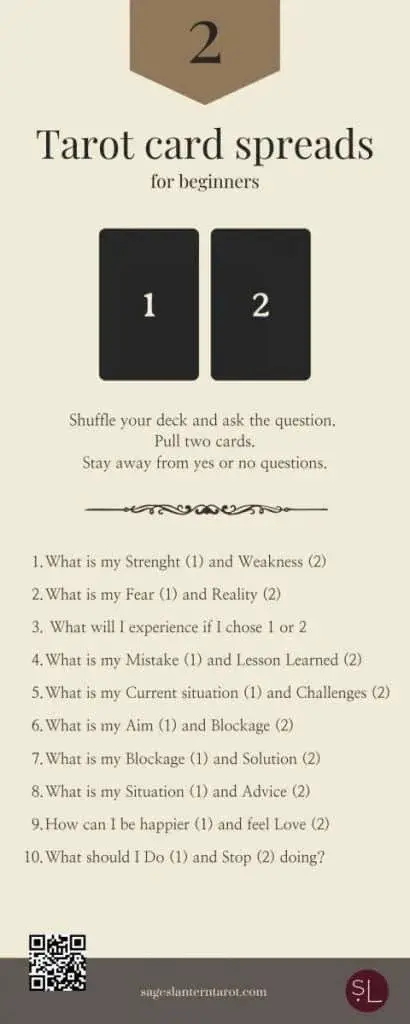
The ten most powerful two-card Tarot spreads for beginners
- What is my Strenght (1) and Weakness (2)
- What is my Fear (1) and Reality (2)
- What will I experience if I chose 1 or 2
- What is my Mistake (1) and Lesson Learned (2)
- What is my Current situation (1) and Challenges (2)
- What is my Aim (1) and Blockage (2)
- What is my Blockage (1) and Solution (2)
- What is my Situation (1) and Advice (2)
- How can I be happier (1) and feel Love (2)
- What should I Do (1) and Stop (2) doing
THEE-CARD TAROT SPREAD EXAMPLES
A three-card Tarot spread is perfect when you want to deep-dive into a question. You don’t need to read reversals (when the card is placed upside down) if you don’t want to. Pin it to your Pinterest for easy access.
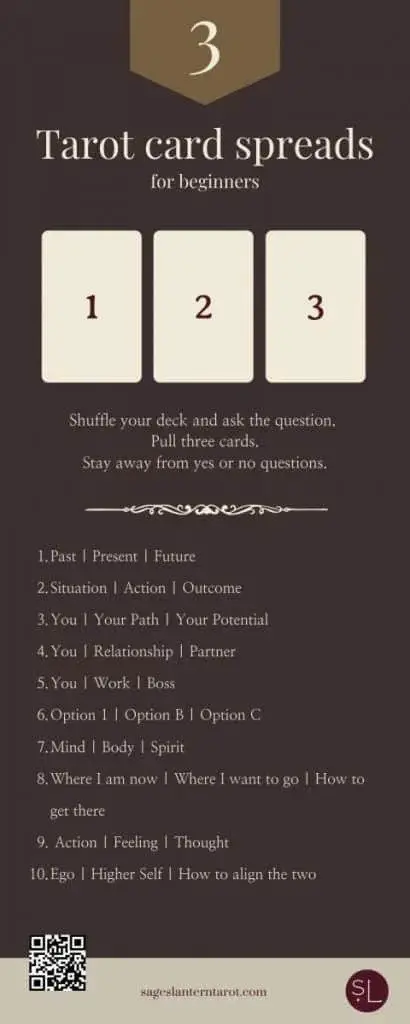
The ten most powerful three-card Tarot spreads for beginners
- Past | Present | Future
- Situation | Action | Outcome
- You | Your Path | Your Potential
- You | Relationship | Partner
- You | Work | Boss
- Option 1 | Option B | Option C
- Mind | Body | Spirit
- Where I am now | Where I want to go | How to get there
- Action | Feeling | Thought
- Ego | Higher Self | How to align the two
Feel free to mix and match and create your custom spreads if needed. The only thing stopping you is your imagination.
WANT TO LEARN MORE?
Learn what Tarot card reversals are and how to read them.
THE MOST COMMON TAROT CARD SPREADS
The most common or famous, Tarot card spreads are the “Past, Present, Future,” “Celtic Cross,” and “the Horseshoe” layout.
- Past, present, future (beginner)
- Horseshoe spread (intermediate)
- Celtic Cross (advanced)
The three-card “Past, Present, Future” Tarot spread is an excellent alternative for beginners. The seven-card Horseshoe spread is more geared towards intermediate readers. The Celtic Cross is quite complex with ten cards and more appropriate for the advanced Tarot reader.
THE PAST, PRESENT, FUTURE TAROT CARD SPREAD
The “Past, Present, Future” Tarot card spread is easy for beginners and is often included in the booklets with a new Tarot card deck. The spread is very hands-on and gives you lots of helpful information. The spread is categorized as a general Tarot spread as you don’t need to ask a specific question.
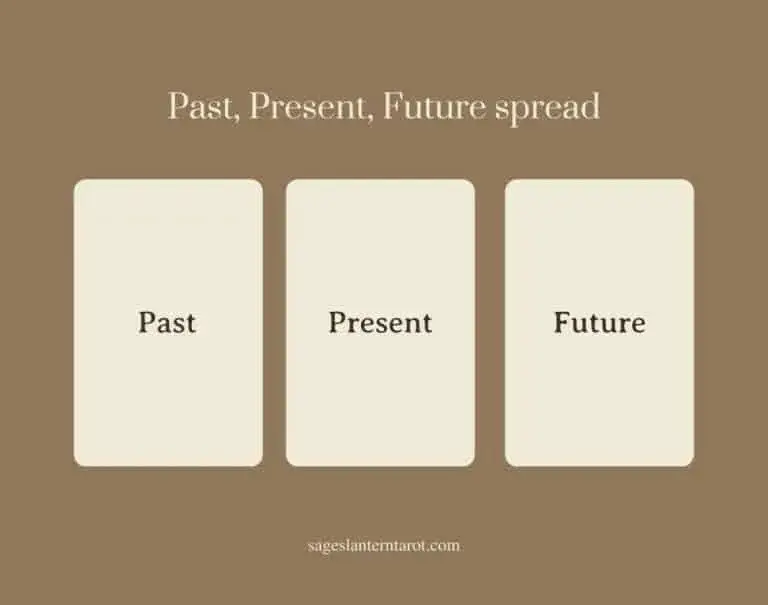
THE HORSESHOE SPREAD
The “Horseshoe” spread is very popular and a great alternative if you are an intermediate reader. The spread is categorized as a general Tarot spread as you don’t have to ask a specific question.
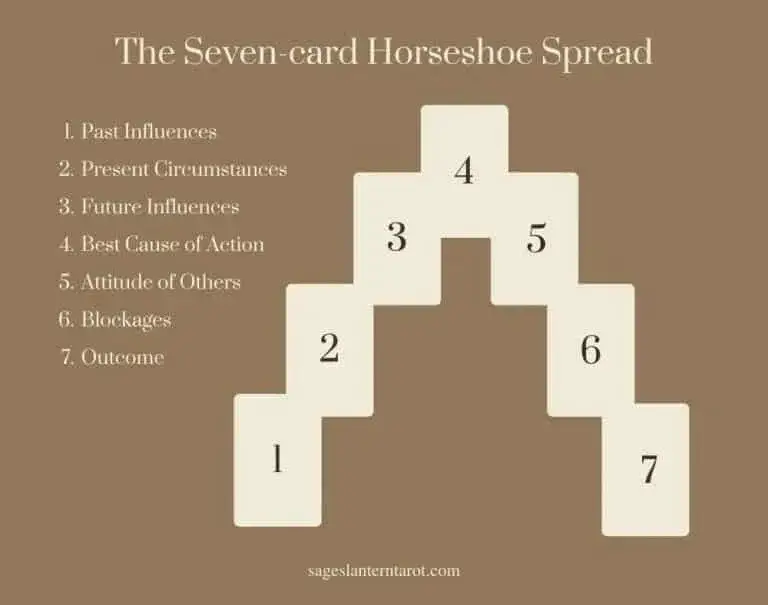
IN SUMMARY
Tarot card spreads are the heartbeat of the Tarot. Without a layout, it is hard for the Tarot reader to decode messages.
A spread does not need to be complex to be powerful. I often use three- to five-card spreads myself. There’s no prestige in this either – you are not less of a reader if you use more restricted spreads.
There are great beginner’s spreads that you can start with to gain confidence. As you grow as a reader, you will find your preferences and favorite ones. Before you know it, you will be creating custom spreads on a whim.
THE DEFINITIONS IN THIS ARTICLE ARE BASED ON THE RIDER WAITE DECK AND SYSTEM.
Recent Post
- Tarot Court Cards: What They AreNot sure what tarot court cards are or look like? No worries, in this article, you learn everything you need to know to identify and understand them.
- 5 Powerful Tarot Spreads for Dream InterpretationThe 5 most potent tarot spreads for interpreting your dreams. A list of common symbols is included.
